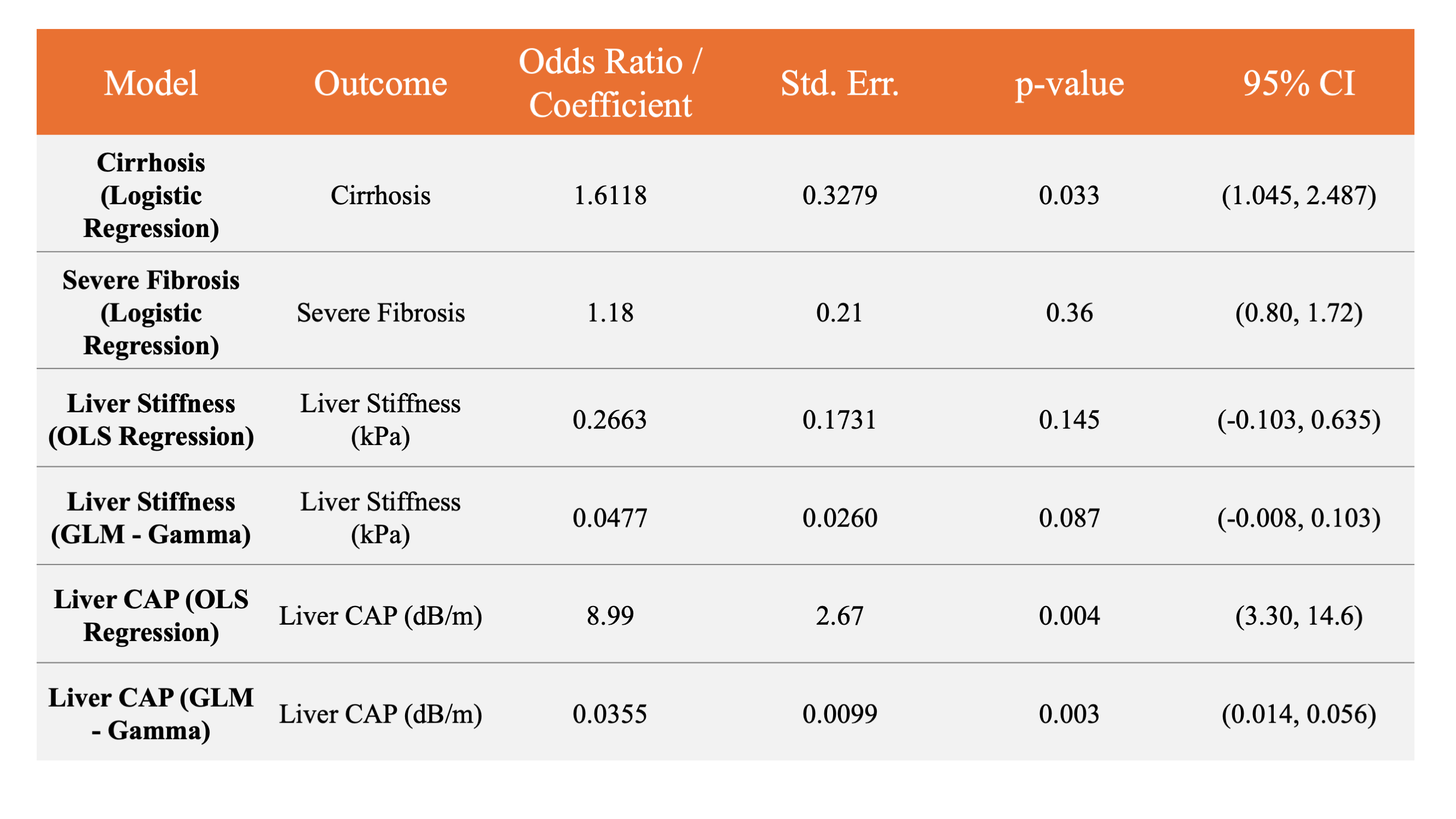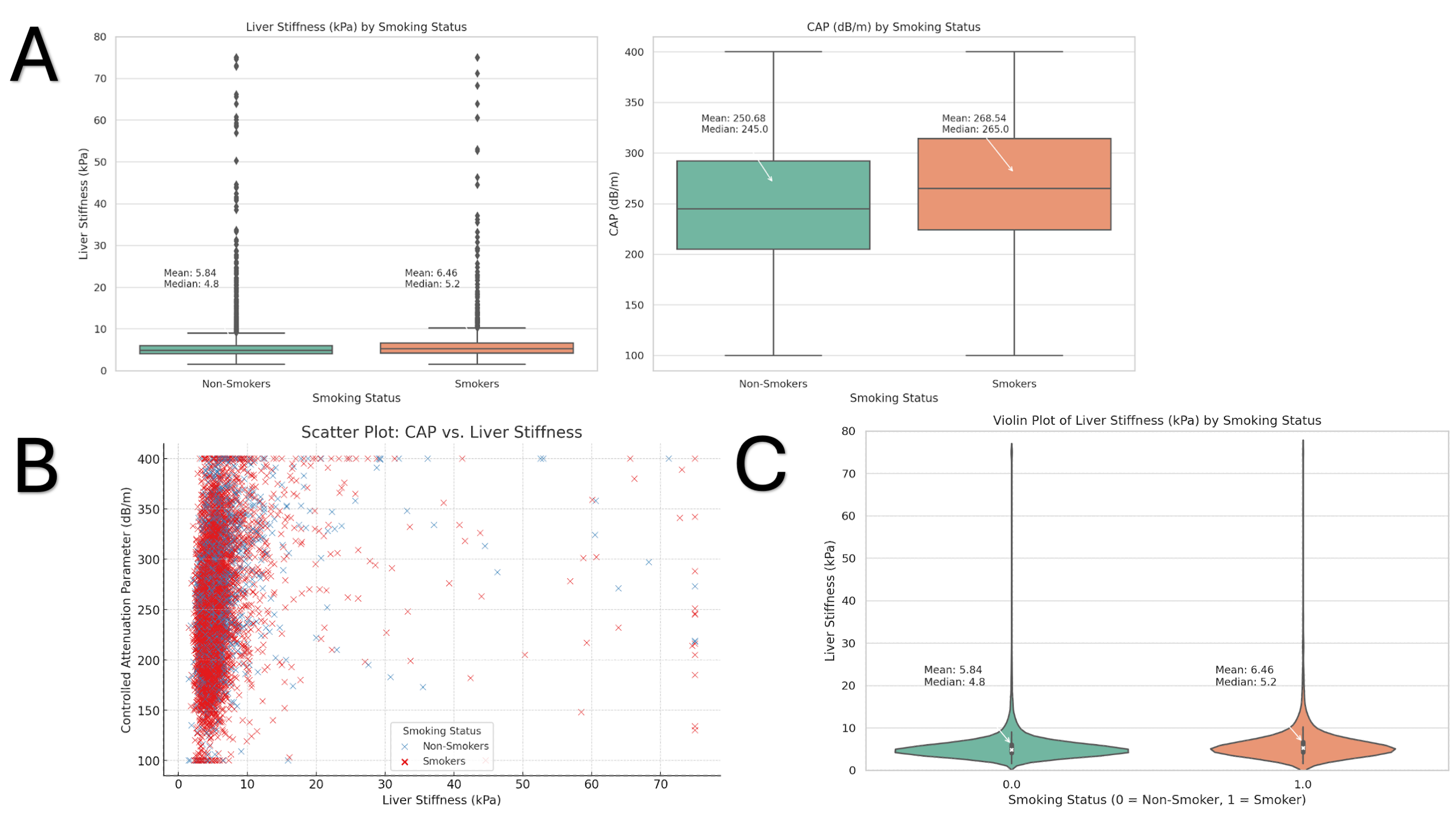Tuesday Poster Session
Category: Liver
P5908 - Cigarette Smoking May Increase the Risk for Cirrhosis, Especially Among Females: Evidence From NHANES 2021-2023
Tuesday, October 28, 2025
10:30 AM - 4:00 PM PDT
Location: Exhibit Hall
- VJ
Vinay Jahagirdar, MD
Virginia Commonwealth University Medical Center
Richmond, VA
Presenting Author(s)
Vinay Jahagirdar, MD1, Hassam Ali, MD2, Khaled M.. Elhusseiny, MD3, Kaanthi Rama, MD4, Fizza Mahmood, MD5, Mehak Sachdeva, MD6, Muhammad Shahzil, MD7, Umar Hayat, MD8, Dushyant S. Dahiya, MD9, Hanna Blaney, MD, MPH10, Luis Antonio Diaz, MD11, Juan Pablo Arab, MD12
1Virginia Commonwealth University Medical Center, Richmond, VA; 2East Carolina Gastroenterology, Greenville, NC; 3East Carolina University Medical Center, Greenville, NC; 4Virginia Commonwealth University Health System, Richmond, VA; 5University of Health Sciences, Lahore, Lahore, Punjab, Pakistan; 6University of Central Florida College of Medicine/HCA Healthcare GME Consortium, Ocala, FL; 7Penn State Health Milton S. Hershey Medical Center, Hershey, PA; 8Geisinger Wyoming Valley Medical Center, Wilkes-Barre, PA; 9University of Kansas School of Medicine, Kansas City, KS; 10MedStar Georgetown University Hospital, Washington, DC; 11University of California San Diego, San Diego, CA; 12Virginia Commonwealth University School of Medicine, Richmond, VA
Introduction: Cigarette smoking significantly contributes to the global disease burden. While its impact on cardiovascular and pulmonary disease is well-established, the relationship with liver disease remains under-investigated. This study aims to evaluate the association between cigarette smoking and liver-related outcomes in the United States (US) using a large, nationally representative dataset.
Methods: Cross-sectional study using the National Health and Nutrition Examination Survey 2021–2023 database. We included adults ≥18 years with valid liver stiffness measurements (LSMs) on vibration-controlled transient elastography (VCTE). Hepatic steatosis was defined by controlled attenuation parameter (CAP) ≥275 dB/m, advanced fibrosis by LSM 9.5–16.6 kPa, and cirrhosis by LSM >16.6 kPa. Survey-weighted logistic and linear regression analyses adjusted for demographic and clinical covariates evaluated associations between smoking status and liver outcomes. Subgroup analyses assessed interactions by gender, age, diabetes, and high-risk alcohol consumption (single session with ≥4 drinks for women or ≥5 drinks for men, or drinking alcohol at least twice/week).
Results: The analysis included around 247 million weighted US adults, 56 millions of whom were current smokers. Smokers were predominantly male, non-Hispanic White, and exhibited higher BMI, waist circumference, diabetes prevalence, and high-risk alcohol consumption (p< 0.01). Compared to non-smokers, smokers showed significantly elevated CAP scores (271.4 vs. 252.2 dB/m, p< 0.001) and increased LSM (6.60 vs. 5.79 kPa, p=0.001) (Fig A-C).
In adjusted model, smoking was associated with increased risk of advanced fibrosis, though not statistically significant (OR 1.18, 95%CI:0.80–1.72, p=0.36). Smoking was associated with significantly higher odds of cirrhosis (odds ratio [OR] 1.61, 95%CI:1.05–2.49, p=0.033) (Table 1). The association was notably stronger in females (OR 3.29, 95%CI:2.18–4.97, p< 0.001) and individuals aged 40–60 years (OR 1.91, 95%CI:1.08–3.38, p=0.027).
Discussion: TThis population-based study demonstrates significant associations between smoking and increased risks of hepatic steatosis and cirrhosis, particularly among women and middle-aged adults. These findings emphasize the need for targeted smoking cessation interventions and further mechanistic research to elucidate tobacco's role in liver disease progression.

Figure: A: Box Plots of Liver Stiffness and Controlled Attenuation Parameter (CAP) by Smoking Status. This figure compares liver stiffness (kPa) and CAP (dB/m) values between individuals who smoke vs individuals who do not smoke using box plots. Individuals who smoke exhibited higher liver stiffness and CAP values, suggesting a possible association between smoking and liver fibrosis and steatosis. The CAP box plot shows a wider distribution among individuals who smoke, which suggests higher variability in liver fat content.

Figure: Table 1: Regression Models Assessing the Impact of Cigarette Smoking on Liver Steatosis and Fibrosis. Adjusted for age, gender (female), race/ethnicity, diabetes, body mass index (BMI), Hepatitis A IgG, reported history of hepatitis B/Hep B surface Ag, and high-risk alcohol use.
Disclosures:
Vinay Jahagirdar indicated no relevant financial relationships.
Hassam Ali indicated no relevant financial relationships.
Khaled Elhusseiny indicated no relevant financial relationships.
Kaanthi Rama indicated no relevant financial relationships.
Fizza Mahmood indicated no relevant financial relationships.
Mehak Sachdeva indicated no relevant financial relationships.
Muhammad Shahzil indicated no relevant financial relationships.
Umar Hayat indicated no relevant financial relationships.
Dushyant Dahiya indicated no relevant financial relationships.
Hanna Blaney indicated no relevant financial relationships.
Luis Antonio Diaz indicated no relevant financial relationships.
Juan Pablo Arab indicated no relevant financial relationships.
Vinay Jahagirdar, MD1, Hassam Ali, MD2, Khaled M.. Elhusseiny, MD3, Kaanthi Rama, MD4, Fizza Mahmood, MD5, Mehak Sachdeva, MD6, Muhammad Shahzil, MD7, Umar Hayat, MD8, Dushyant S. Dahiya, MD9, Hanna Blaney, MD, MPH10, Luis Antonio Diaz, MD11, Juan Pablo Arab, MD12. P5908 - Cigarette Smoking May Increase the Risk for Cirrhosis, Especially Among Females: Evidence From NHANES 2021-2023, ACG 2025 Annual Scientific Meeting Abstracts. Phoenix, AZ: American College of Gastroenterology.
1Virginia Commonwealth University Medical Center, Richmond, VA; 2East Carolina Gastroenterology, Greenville, NC; 3East Carolina University Medical Center, Greenville, NC; 4Virginia Commonwealth University Health System, Richmond, VA; 5University of Health Sciences, Lahore, Lahore, Punjab, Pakistan; 6University of Central Florida College of Medicine/HCA Healthcare GME Consortium, Ocala, FL; 7Penn State Health Milton S. Hershey Medical Center, Hershey, PA; 8Geisinger Wyoming Valley Medical Center, Wilkes-Barre, PA; 9University of Kansas School of Medicine, Kansas City, KS; 10MedStar Georgetown University Hospital, Washington, DC; 11University of California San Diego, San Diego, CA; 12Virginia Commonwealth University School of Medicine, Richmond, VA
Introduction: Cigarette smoking significantly contributes to the global disease burden. While its impact on cardiovascular and pulmonary disease is well-established, the relationship with liver disease remains under-investigated. This study aims to evaluate the association between cigarette smoking and liver-related outcomes in the United States (US) using a large, nationally representative dataset.
Methods: Cross-sectional study using the National Health and Nutrition Examination Survey 2021–2023 database. We included adults ≥18 years with valid liver stiffness measurements (LSMs) on vibration-controlled transient elastography (VCTE). Hepatic steatosis was defined by controlled attenuation parameter (CAP) ≥275 dB/m, advanced fibrosis by LSM 9.5–16.6 kPa, and cirrhosis by LSM >16.6 kPa. Survey-weighted logistic and linear regression analyses adjusted for demographic and clinical covariates evaluated associations between smoking status and liver outcomes. Subgroup analyses assessed interactions by gender, age, diabetes, and high-risk alcohol consumption (single session with ≥4 drinks for women or ≥5 drinks for men, or drinking alcohol at least twice/week).
Results: The analysis included around 247 million weighted US adults, 56 millions of whom were current smokers. Smokers were predominantly male, non-Hispanic White, and exhibited higher BMI, waist circumference, diabetes prevalence, and high-risk alcohol consumption (p< 0.01). Compared to non-smokers, smokers showed significantly elevated CAP scores (271.4 vs. 252.2 dB/m, p< 0.001) and increased LSM (6.60 vs. 5.79 kPa, p=0.001) (Fig A-C).
In adjusted model, smoking was associated with increased risk of advanced fibrosis, though not statistically significant (OR 1.18, 95%CI:0.80–1.72, p=0.36). Smoking was associated with significantly higher odds of cirrhosis (odds ratio [OR] 1.61, 95%CI:1.05–2.49, p=0.033) (Table 1). The association was notably stronger in females (OR 3.29, 95%CI:2.18–4.97, p< 0.001) and individuals aged 40–60 years (OR 1.91, 95%CI:1.08–3.38, p=0.027).
Discussion: TThis population-based study demonstrates significant associations between smoking and increased risks of hepatic steatosis and cirrhosis, particularly among women and middle-aged adults. These findings emphasize the need for targeted smoking cessation interventions and further mechanistic research to elucidate tobacco's role in liver disease progression.

Figure: A: Box Plots of Liver Stiffness and Controlled Attenuation Parameter (CAP) by Smoking Status. This figure compares liver stiffness (kPa) and CAP (dB/m) values between individuals who smoke vs individuals who do not smoke using box plots. Individuals who smoke exhibited higher liver stiffness and CAP values, suggesting a possible association between smoking and liver fibrosis and steatosis. The CAP box plot shows a wider distribution among individuals who smoke, which suggests higher variability in liver fat content.

Figure: Table 1: Regression Models Assessing the Impact of Cigarette Smoking on Liver Steatosis and Fibrosis. Adjusted for age, gender (female), race/ethnicity, diabetes, body mass index (BMI), Hepatitis A IgG, reported history of hepatitis B/Hep B surface Ag, and high-risk alcohol use.
Disclosures:
Vinay Jahagirdar indicated no relevant financial relationships.
Hassam Ali indicated no relevant financial relationships.
Khaled Elhusseiny indicated no relevant financial relationships.
Kaanthi Rama indicated no relevant financial relationships.
Fizza Mahmood indicated no relevant financial relationships.
Mehak Sachdeva indicated no relevant financial relationships.
Muhammad Shahzil indicated no relevant financial relationships.
Umar Hayat indicated no relevant financial relationships.
Dushyant Dahiya indicated no relevant financial relationships.
Hanna Blaney indicated no relevant financial relationships.
Luis Antonio Diaz indicated no relevant financial relationships.
Juan Pablo Arab indicated no relevant financial relationships.
Vinay Jahagirdar, MD1, Hassam Ali, MD2, Khaled M.. Elhusseiny, MD3, Kaanthi Rama, MD4, Fizza Mahmood, MD5, Mehak Sachdeva, MD6, Muhammad Shahzil, MD7, Umar Hayat, MD8, Dushyant S. Dahiya, MD9, Hanna Blaney, MD, MPH10, Luis Antonio Diaz, MD11, Juan Pablo Arab, MD12. P5908 - Cigarette Smoking May Increase the Risk for Cirrhosis, Especially Among Females: Evidence From NHANES 2021-2023, ACG 2025 Annual Scientific Meeting Abstracts. Phoenix, AZ: American College of Gastroenterology.

